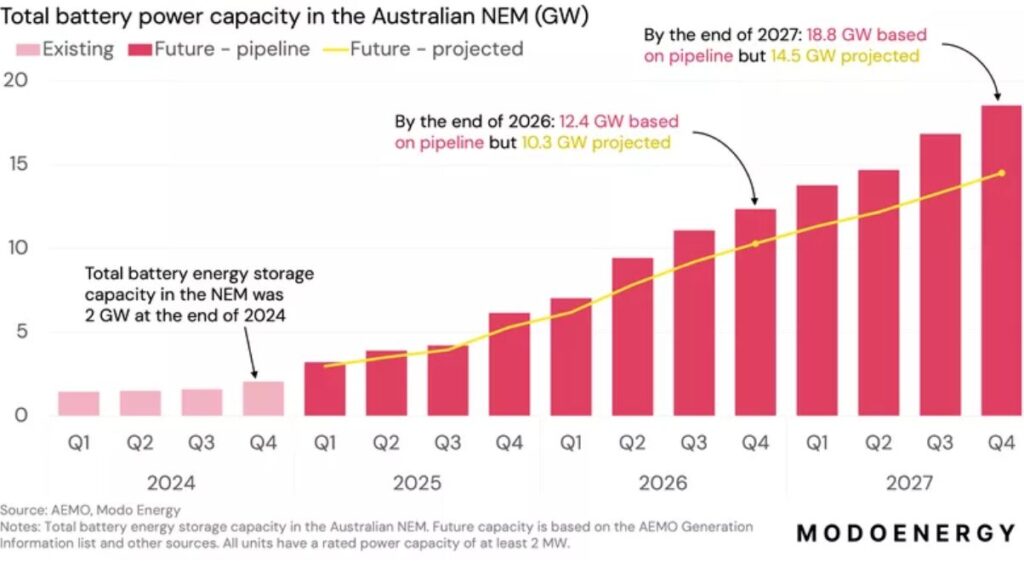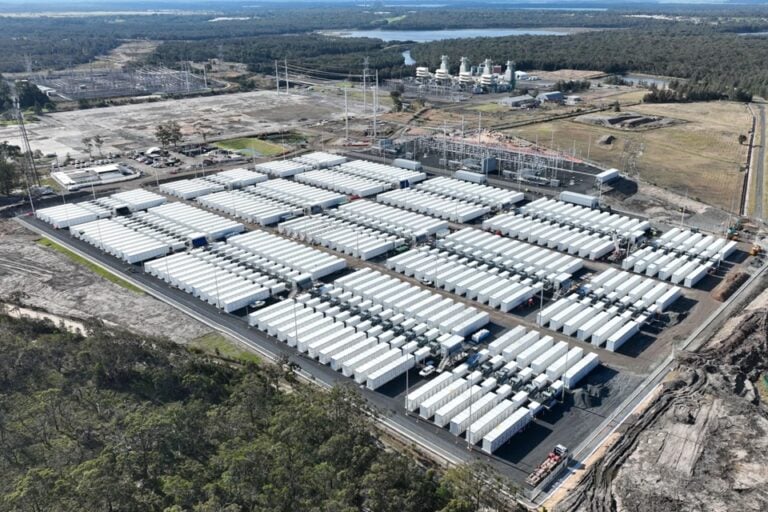Australia’s NEM operates in the eastern and southeastern parts of the country and connects South Australia, Victoria, New South Wales, the Australian Capital Territory, Queensland and Tasmania. These grid areas have historically relied on coal-fired power and fossil fuels.
With the withdrawal of these polluting generation technologies, a shift towards variable renewable energy complemented with energy storage has become the spearhead of the country’s energy transition. The Australian Energy Market Operator (AEMO) predicts that coal-fired power in the country will be fully withdrawn by 2038.
Modo references the shift from coal-fired power on the NEM as a key driver of BESS developments. The company details that New South Wales, Queensland, and Victoria combined comprise 88% of the NEM’s annual energy demand. Thus, it is unsurprising that most of the anticipated 16.8GW of BESS development pipeline is concentrated in these three states.
Specifically, 6GW is forecast to be located in New South Wales, 4.8GW in Queensland, and 3.9GW in Victoria. The graph below breaks down each state’s forecasted BESS capacity to 2027.

A rise in big batteries spurs capacity growth
The growth of BESS capacity on the NEM coincides with a market trend to build bigger batteries. Modo states that 20 projects with a capacity of 300MW or greater, around 50% of the development pipeline, will be switched on by 2028.
One of the largest of these projects is the 2.8GWh Eraring power station development being pursued on the site of New South Wales’ largest coal-fired power plant. Australian utility Origin Energy is pursuing the project, which has been divided into three stages.
Stage one of the project features a 460MW BESS with a 2-hour duration (920MWh). Stage two will add a further 240MW. The 700MWh third stage will enable the Eraring BESS to reach 2,800MWh capacity, enabling it to match the 2.8GW power output of the black coal-fired power station. Finnish marine and energy technology group Wärtsilä has been contracted to deliver the BESS for all three stages.
The Eraring BESS is hoped to be fully operational by the end of 2027. Stages one and three will be completed in the final quarter of 2025, followed by stage two in 2027.
Alongside the Eraring BESS, the 850MW/1,680MWh Waratah Super Battery in New South Wales is also set to be fully operational in August 2025. Akaysha Energy, a developer backed by asset manager BlackRock, is behind the energy storage project, which was previously deemed a ‘giant shock absorber’ for the grid.
The first stage of the Waratah BESS energisation was completed in September, yet despite not being fully operational, this has not prevented the battery from already supporting the grid at times of need.
On 27 November, the Waratah Super Battery was called upon to prevent widespread blackouts amid a heatwave in New South Wales. AEMO issued a notice at around 2pm calling for the BESS to maintain 96MWh of energy storage to the NEM at 3pm amid surging demand throughout a heatwave. This was to last until 7pm.
Other notable projects set to come online by the end of 2027 include the 600MW/1,600MWh Melbourne Renewable Energy Hub, the 222MW/640MWh Goulburn River solar-plus-storage site in New South Wales, and the 300MW/650MW Mortlake BESS in Victoria.
Duration of batteries on the NEM increase
Not only are the batteries connecting to the NEM getting bigger, but they are also expected to be longer in duration, shifting from an average of 1.5 hours to 2.5 hours by the end of 2027.
According to Modo, the total energy capacity of batteries in the pipeline to the end of 2027 is 42.8GWh, around 14 times the 3GWh operational at the end of 2024. 95% of the pipeline consists of 2-hour duration or higher batteries, including 4-hour and 8-hour duration systems.
Although reasoning has been provided for this rise in battery duration, research firm Wood Mackenzie said last year that 4-hour battery systems would be more profitable in the future than the typical 1.6-hour duration of projects operating currently.
The firm adds that the capital expenditure (CAPEX) for 4-hour batteries is expected to decrease by 20% by 2030, making investments in this technology more economically attractive.
As such, Wood Mackenzie’s research outlined that a 4-hour battery that starts operations in 2026 is projected to generate an average annual revenue of AU$263,000/MW (US$165,000/MW) over its lifetime. Batteries in Queensland are expected to lead at AU$281,000/MW.
This research follows a report from Australia’s Commonwealth Scientific and Industrial Research Organisation (CSIRO) that found that large-scale BESS capital costs improved the most in 2024-25, falling by 20% year-on-year.

